最新倒装句用法总结
倒装句的用法

倒装句的用法第一篇:倒装句的基本用法倒装句是英语语法中常见的句式结构之一,它与正常语序相比,将谓语动词、助动词、系动词或一些副词短语置于主语之前,从而实现特殊的语言效果。
这种句式在英语中经常被用于强调、修辞、疑问、条件句以及其他一些特定语境下。
一、完全倒装句完全倒装句是指将谓语动词全部置于主语之前的句子结构,形式为:助动词/系动词/副词+主语+谓语动词。
例如:1. Never have I seen such a beautiful sunset.我从未见过如此美丽的日落。
(表示强调的完全倒装句)2. On the top of the hill stands a small cottage.小屋矗立在山顶上。
(表示位置的完全倒装句)3. So nervous was he that he could hardly speak.他如此紧张以至于几乎说不出话来。
(表示程度的完全倒装句)二、部分倒装句部分倒装句是将助动词、系动词、或副词短语放在句首的句子结构,形式为:助动词/系动词/副词+主语+谓语动词。
例如:1. Can you speak French?你会说法语吗?(疑问句的部分倒装句)2. Here comes the bus.公共汽车来了。
(表示位置的部分倒装句)3. Not only is he smart, but he is also talented.他不仅聪明,而且很有才华。
(表示强调的部分倒装句)三、条件句中的倒装句在条件句中,如果将介词短语放在句首,也可以使用倒装句的结构。
例如:1. Should you need any assistance, please don't hesitate to contact us.如果您需要任何帮助,请随时联系我们。
(表示条件的倒装句)四、其他情况下的倒装句除了上述情况外,倒装句还可出现在其他一些情况下,例如:1. Only when we truly understand ourselves can we achieve real happiness.只有当我们真正了解自己时,我们才能获得真正的幸福。
倒装句的用法与例句
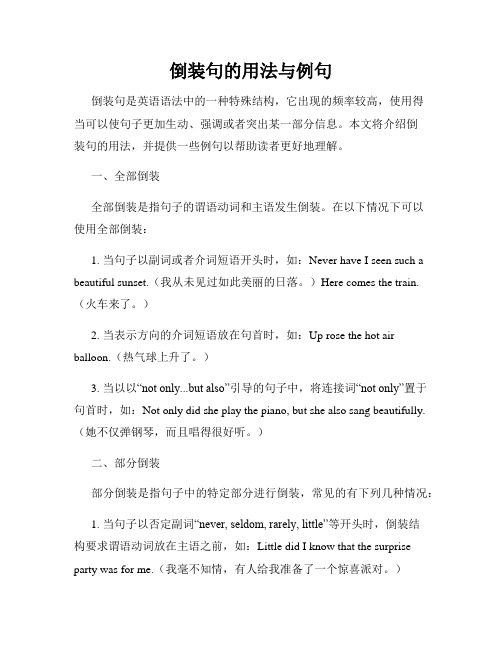
倒装句的用法与例句倒装句是英语语法中的一种特殊结构,它出现的频率较高,使用得当可以使句子更加生动、强调或者突出某一部分信息。
本文将介绍倒装句的用法,并提供一些例句以帮助读者更好地理解。
一、全部倒装全部倒装是指句子的谓语动词和主语发生倒装。
在以下情况下可以使用全部倒装:1. 当句子以副词或者介词短语开头时,如:Never have I seen such a beautiful sunset.(我从未见过如此美丽的日落。
)Here comes the train.(火车来了。
)2. 当表示方向的介词短语放在句首时,如:Up rose the hot air balloon.(热气球上升了。
)3. 当以以“not only...but also”引导的句子中,将连接词“not only”置于句首时,如:Not only did she play the piano, but she also sang beautifully.(她不仅弹钢琴,而且唱得很好听。
)二、部分倒装部分倒装是指句子中的特定部分进行倒装,常见的有下列几种情况:1. 当句子以否定副词“never, seldom, rarely, little”等开头时,倒装结构要求谓语动词放在主语之前,如:Little did I know that the surprise party was for me.(我毫不知情,有人给我准备了一个惊喜派对。
)2. 当句子以表示条件的副词或者介词短语开头时,也可以使用倒装,如:Should you need any assistance, please feel free to ask.(如果你需要任何帮助,请随时提问。
)In case of emergency, break the glass.(紧急情况下,打破玻璃。
)3. 当句子中有“so/such...that”结构时,可以使用倒装结构,如:She was so tired that not only could she not finish her homework, but she alsofell asleep in class.(她太累以至于不仅没有完成她的家庭作业,还在课堂上睡着了。
英语倒装句的归纳总结
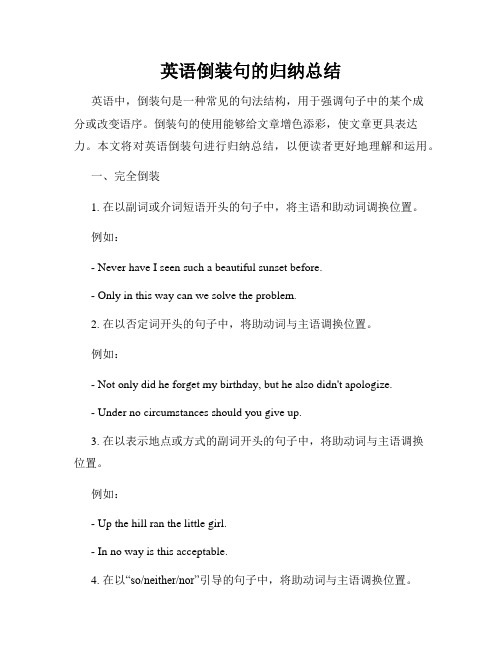
英语倒装句的归纳总结英语中,倒装句是一种常见的句法结构,用于强调句子中的某个成分或改变语序。
倒装句的使用能够给文章增色添彩,使文章更具表达力。
本文将对英语倒装句进行归纳总结,以便读者更好地理解和运用。
一、完全倒装1. 在以副词或介词短语开头的句子中,将主语和助动词调换位置。
例如:- Never have I seen such a beautiful sunset before.- Only in this way can we solve the problem.2. 在以否定词开头的句子中,将助动词与主语调换位置。
例如:- Not only did he forget my birthday, but he also didn't apologize.- Under no circumstances should you give up.3. 在以表示地点或方式的副词开头的句子中,将助动词与主语调换位置。
例如:- Up the hill ran the little girl.- In no way is this acceptable.4. 在以“so/neither/nor”引导的句子中,将助动词与主语调换位置。
例如:- So beautiful is the scenery that it takes my breath away.- Neither have I finished my homework, nor has my brother.二、部分倒装1. 在以“if/whether”引导的条件句中。
例如:- If you work hard, you will achieve your goals.- Whether he comes or not, we will have the party.2. 在以“so that/such that”引导的结果状语从句中。
例如:- He spoke so quickly that I couldn't catch up with him.- The problem is such that it requires a professional to solve it.3. 在以“as/though”引导的方式状语从句中。
英语倒装句用法小结(合集五篇)

英语倒装句用法小结(合集五篇)第一篇:英语倒装句用法小结倒装句用法小结一般来说,倒装分为全部倒装和部分倒装,有的倒装是因为语法需要而出现的,有的倒装则是因为结构平衡的需要而出现的。
一、完全倒装(主谓倒装)是指把谓语全部提到主语的前面。
例:In a lecture hall of a university in England sits a professor.1.以here, there,now, then引导的句子,要完全倒装。
这种句子中的谓语动词通常是不及物动词。
如:Here comes the train!/ There goes the bell!注意:若代词作主语,只把该副词提前主谓语序不变。
Here he comes./ Here it is.2句首是拟声词或 out , in , up ,away , down 等副词,句子要完全倒装。
(注意,这时句子的主语也必须是名词。
如果是人称代词,也不能使用倒装结构。
)如:Up went the rocket./Up it went.3.介词短语作状语在句首,句子要完全倒装。
注意,这时句子的谓语动词通常是不及物动词。
如:In the front of the lecture hall sat the speaker.4.表语置于句首,且主语较长或结构较复杂的句子要用全部倒装。
如:Gone are the days when we ha nothing to eat.5.so/ neither/ nor 表前面所说的情况也适合于后者,其倒装结构为“so/ neither/ nor+助动词/系动词/情态动词”,这里的主语同前一个句子的主语指的是同一人或物。
如:She has finished her homework, so has her brother.She hasn’t gone there, neither/ nor has he.二、部分倒装(助动词倒装)是指把谓语的一部分(助动词)提到主语的前面。
倒装句的用法规则口诀

倒装句的用法规则口诀一、倒装句的用法规则倒装句是英语语法中常见的一种结构,它与正常语序不同,其主谓之间的位置发生了颠倒。
在英语中,倒装句的使用相对灵活多样,但也有一些固定的规则和口诀可以辅助学习和记忆。
下面我将为大家介绍倒装句的用法规则及相关口诀。
1.完全倒装在以下情况下,需要进行完全倒装:- 在表示地点或方向的副词位于句首时- Up the hill walked the old man.(老人沿着山走上去了。
)- Out of the room rushed the cat.(猫从房间里冲出来了。
)- 在以否定词开头的副词置于句首时- Never have I seen such a beautiful sunset.(我从未见过如此美丽的日落。
)- Not only is he intelligent, but he also has a great sense of humor.(他不仅聪明而且还很幽默。
)2.半倒装半倒装指的是部分动词前移,而主语依然位于动词之后。
- 当以“only+状语”开头时- Only by working hard can you achieve success.(只有通过努力你才能取得成功。
)- 当以“so+形容词/副词+be/do/have+主语”结构开头时- So beautiful is the view that it takes my breath away.(美景如此令人惊叹,不禁让我屏住了呼吸。
)- 在以否定词“never”或“nor”开头的句子中- Never have I been so excited.(我从未这么兴奋过。
)- Nor did he notice the warning sign.(他也没有注意到警示牌。
)3.助动词倒装在一些特殊的情况下,助动词需要与主语发生位置上的倒装。
- 在表示强调的句子中- It is Mary who won the competition.(是玛丽赢得了比赛。
英语倒装句12种类型及例句
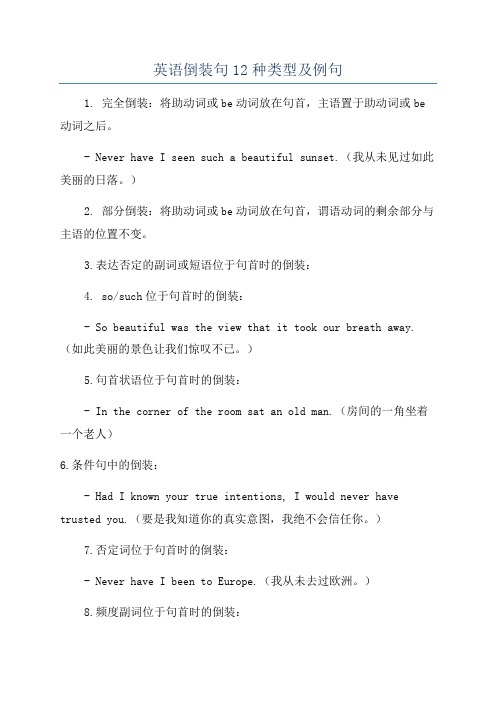
英语倒装句12种类型及例句1. 完全倒装:将助动词或be动词放在句首,主语置于助动词或be 动词之后。
- Never have I seen such a beautiful sunset.(我从未见过如此美丽的日落。
)2. 部分倒装:将助动词或be动词放在句首,谓语动词的剩余部分与主语的位置不变。
3.表达否定的副词或短语位于句首时的倒装:4. so/such位于句首时的倒装:- So beautiful was the view that it took our breath away.(如此美丽的景色让我们惊叹不已。
)5.句首状语位于句首时的倒装:- In the corner of the room sat an old man.(房间的一角坐着一个老人)6.条件句中的倒装:- Had I known your true intentions, I would never have trusted you.(要是我知道你的真实意图,我绝不会信任你。
)7.否定词位于句首时的倒装:- Never have I been to Europe.(我从未去过欧洲。
)8.频度副词位于句首时的倒装:- Rarely do we see such dedication.(我们很少见到如此的奉献精神。
)9.祈使句或祈使句部分的倒装:- Stand up!(站起来!)- Be quiet, please.(请安静。
)10. only位于句首时的倒装:- Only by working hard can you achieve your goals.(只有通过努力工作,你才能实现目标。
)11.地点状语置于句首时的倒装:- In the garden were beautiful flowers.(花园里有美丽的花朵。
)12.宾语置于句首时的倒装:- A love like this I have never felt before.(我之前从未感受过如此的爱。
倒装句的使用技巧和特殊情况

倒装句的使用技巧和特殊情况倒装句是英语中一种常用的句子结构,与常规语序相反,即将谓语动词或助动词放在主语之前。
倒装句的使用可以使句子更生动、更突出,同时也有一些特殊情况需要注意。
本文将介绍倒装句的使用技巧和特殊情况。
一、完全倒装句完全倒装句是指将整个谓语动词或助动词放在主语之前。
1.使用助动词倒装:— Are you ready for the exam?— Ready for the exam, are you?准备好考试了吗?准备好考试了。
在一般疑问句中,助动词通常位于主语之前,但在完全倒装句中,则将助动词与主语调换位置。
2.使用动词倒装:— In came the teacher with a smile on her face.— With a smile on her face, in came the teacher.老师笑着走了进来。
笑着走了进来的是老师。
在一些表达方式特殊的句子中,动词可以直接放在主语之前,使句子更加生动。
二、部分倒装句部分倒装句是指将谓语动词或助动词的某一部分放在主语之前。
常见的部分倒装句包括:否定副词、表示方向的副词、表示频率的副词、表示条件的介词短语等。
1.否定副词或词组倒装:— Never have I seen such a beautiful sunset.— Not only does she speak English, but she also speaks French.我从未见过如此美丽的日落。
她不仅会说英语,还会说法语。
在句首出现否定副词或词组时,谓语助动词或动词需要与主语倒装。
2.表示方向的副词倒装:— Up went the hot air balloon into the sky.— Down came the rain, washing away all the dust.热气球冉冉升起。
雨水下了下来,冲刷走了所有的尘埃。
在句首出现表示方向的副词时,谓语助动词或动词需要与主语倒装。
倒装句语法知识点归纳总结
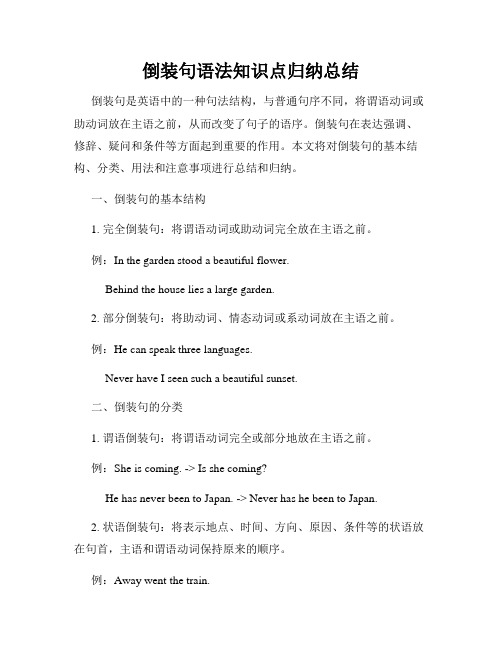
倒装句语法知识点归纳总结倒装句是英语中的一种句法结构,与普通句序不同,将谓语动词或助动词放在主语之前,从而改变了句子的语序。
倒装句在表达强调、修辞、疑问和条件等方面起到重要的作用。
本文将对倒装句的基本结构、分类、用法和注意事项进行总结和归纳。
一、倒装句的基本结构1. 完全倒装句:将谓语动词或助动词完全放在主语之前。
例:In the garden stood a beautiful flower.Behind the house lies a large garden.2. 部分倒装句:将助动词、情态动词或系动词放在主语之前。
例:He can speak three languages.Never have I seen such a beautiful sunset.二、倒装句的分类1. 谓语倒装句:将谓语动词完全或部分地放在主语之前。
例:She is coming. -> Is she coming?He has never been to Japan. -> Never has he been to Japan.2. 状语倒装句:将表示地点、时间、方向、原因、条件等的状语放在句首,主语和谓语动词保持原来的顺序。
例:Away went the train.In the distance could be seen a tall tower.3. 主从倒装句:主句和从句中的主语-谓语结构进行倒装。
例:Not until she finished her homework did she go to bed.Only when the rain stopped could we go outside.三、倒装句的用法1. 强调句:通过倒装句,可以将句子的某一部分进行强调,常用的结构是完全倒装句和部分倒装句。
例:Not only did he win the game, but he also broke the record.Under no circumstances should you touch the red button.2. 疑问句:直接将谓语动词或助动词放在主语之前形成疑问句。
倒装句的用法归纳总结
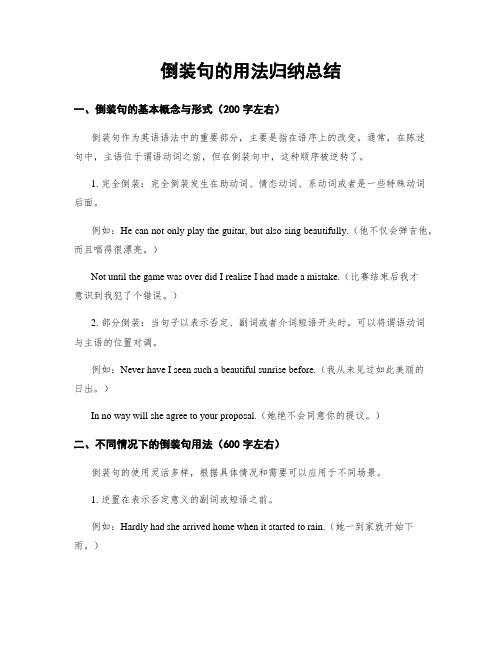
倒装句的用法归纳总结一、倒装句的基本概念与形式(200字左右)倒装句作为英语语法中的重要部分,主要是指在语序上的改变。
通常,在陈述句中,主语位于谓语动词之前,但在倒装句中,这种顺序被逆转了。
1. 完全倒装:完全倒装发生在助动词、情态动词、系动词或者是一些特殊动词后面。
例如:He can not only play the guitar, but also sing beautifully.(他不仅会弹吉他,而且唱得很漂亮。
)Not until the game was over did I realize I had made a mistake.(比赛结束后我才意识到我犯了个错误。
)2. 部分倒装:当句子以表示否定、副词或者介词短语开头时,可以将谓语动词与主语的位置对调。
例如:Never have I seen such a beautiful sunrise before.(我从未见过如此美丽的日出。
)In no way will she agree to your proposal.(她绝不会同意你的提议。
)二、不同情况下的倒装句用法(600字左右)倒装句的使用灵活多样,根据具体情况和需要可以应用于不同场景。
1. 逆置在表示否定意义的副词或短语之前。
例如:Hardly had she arrived home when it started to rain.(她一到家就开始下雨。
)Under no circumstances should you disturb the birds' nests.(在任何情况下都不应该打扰鸟巢。
)2. 用于强调句子中的某一成分。
例如:It is in the library that students can find a quiet place to study.(只有在图书馆里学生才能找到一个安静的地方学习。
)Only after years of practice can one master a musical instrument perfectly.(只有经过多年的练习,一个人才能完美地掌握一种乐器。
倒装句用法总结(通用4篇)
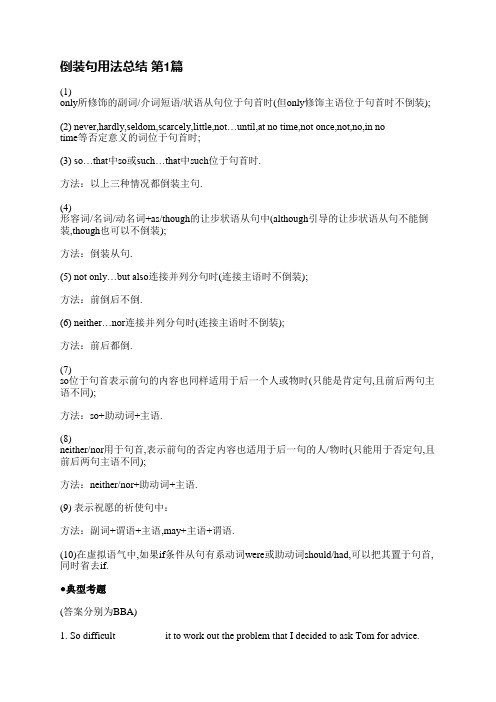
倒装句用法总结第1篇(1)only所修饰的副词/介词短语/状语从句位于句首时(但only修饰主语位于句首时不倒装);(2) never,hardly,seldom,scarcely,little,not…until,at no time,not once,not,no,in notime等否定意义的词位于句首时;(3) so…that中so或such…that中such位于句首时.方法:以上三种情况都倒装主句.(4)形容词/名词/动名词+as/though的让步状语从句中(although引导的让步状语从句不能倒装,though也可以不倒装);方法:倒装从句.(5) not only…but also连接并列分句时(连接主语时不倒装);方法:前倒后不倒.(6) neither…nor连接并列分句时(连接主语时不倒装);方法:前后都倒.(7)so位于句首表示前句的内容也同样适用于后一个人或物时(只能是肯定句,且前后两句主语不同);方法:so+助动词+主语.(8)neither/nor用于句首,表示前句的否定内容也适用于后一句的人/物时(只能用于否定句,且前后两句主语不同);方法:neither/nor+助动词+主语.(9) 表示祝愿的祈使句中:方法:副词+谓语+主语,may+主语+谓语.(10)在虚拟语气中,如果if条件从句有系动词were或助动词should/had,可以把其置于句首,同时省去if.●典型考题(答案分别为BBA)1. So difficult _________ it to work out the problem that I decided to ask Tom for advice.A. I did findB. did I findC. I have foundD. have I found2. _________ about wild plants that they decided to make a trip to Madagascar for further research.A. so curious the couple wasB. So curious were the coupleC. How curious the couple wereD. The couple was such curious3. —It’s burning hot today, isn’t it?—Yes. _________ yesterday.A. So was itB. So it wasC. So it isD. So is it特别说明:(1)若前面提出某一否定的情况,要表示后者也属于同样的否定情况,则应将其中的so改为neither或nor。
倒装句的用法
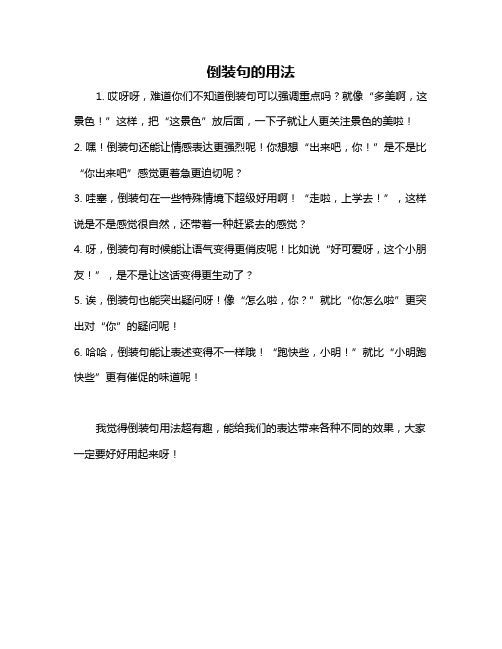
倒装句的用法
1. 哎呀呀,难道你们不知道倒装句可以强调重点吗?就像“多美啊,这景色!”这样,把“这景色”放后面,一下子就让人更关注景色的美啦!
2. 嘿!倒装句还能让情感表达更强烈呢!你想想“出来吧,你!”是不是比“你出来吧”感觉更着急更迫切呢?
3. 哇塞,倒装句在一些特殊情境下超级好用啊!“走啦,上学去!”,这样说是不是感觉很自然,还带着一种赶紧去的感觉?
4. 呀,倒装句有时候能让语气变得更俏皮呢!比如说“好可爱呀,这个小朋友!”,是不是让这话变得更生动了?
5. 诶,倒装句也能突出疑问呀!像“怎么啦,你?”就比“你怎么啦”更突出对“你”的疑问呢!
6. 哈哈,倒装句能让表述变得不一样哦!“跑快些,小明!”就比“小明跑快些”更有催促的味道呢!
我觉得倒装句用法超有趣,能给我们的表达带来各种不同的效果,大家一定要好好用起来呀!。
倒装句的用法归纳总结

倒装句的用法归纳总结一、完全倒装完全倒装通常只用于一般现在时和一般过去时,常见的结构有:1. 表示时间now,then等或方位here,there,up,down,in,out,away,off,inside,outside等的副词,以及表示地点的介词短语in the room,on the wall 等置于句首,且主语为名词时,句子要用完全倒装结构。
主语为人称代词时不倒装。
There goes the bell.Then came the chairman.At the foot of the mountain lies a village,where people still livea peaceful life.Ahead sat an old woman.Here he comes. Away they went.二、部分倒装1. only所修饰的副词/介词短语/状语从句位于句首时(作状语用)Only in this way, can you learn English well.Only when you are a parent will you understand how I feel now.2. never, hardly, seldom, scarcely, little,not…until, not, no, by no mean, at no time等否定意义的词位于句首时Never have I seen such a performance.Nowhere will you find the answer to this question.Not until the child fell asleep did the mother leave the room.No sooner had they arrived at home than it began to rain heavily.注意:not only…but also连接并列分句时,not only部分要倒装(连接主语时不倒装)Not only did he refuse the gift, he also severely criticized the sender.3. so…that中so或such…that中such位于句首时So frightened was he that he dared not go home alone.Such a careless girl was she that he made the mistake a third time.4. so位于句首表示前句的内容也同样适用于后一个人或物时(只能是肯定句,且前后两句主语不同); neither/nor用于句首,表示前句的否定内容也适用于后一句的人/物时(只能用于否定句,且前后两句主语不同)He likes chatting. So does his wife.If you won't go, neither will I.5. 在虚拟语气中,如果if条件从句有系动词were或助动词should/had,可以把其置于句首,同时省去if.Were it to rain, we would cancel the plan.。
倒装句的用法总结

倒装句的用法总结
倒装句是英语语法中一种常见的句式结构,用于强调句子的其中一部分或在特定情况下使用。
以下是关于倒装句的用法总结:
1. 将助动词置于主语之前的倒装句:在一般疑问句中,助动词被置于主语之前,例如:"Do you like chocolate?"(你喜欢巧克力吗?)在以否定形式构成的句子中,助动词和表示否定的词一起置于主语之前,例如:"She does not want to go."(她不想去。
)
2. 在以副词或介词短语开头的句子中的倒装句:在以副词或介词短语开头的句子中,主语和谓语动词发生倒装,例如:"Seldom do I go to parties."(我很少去参加派对。
)另一个例子是:"Under the table lies a hidden treasure."(桌子下面藏着一份隐藏的宝藏。
)
3. 在强调句中使用倒装句:为了强调句子中的其中一部分,可以使用倒装句,例如:"It was John who broke the vase."(是约翰打破了花瓶。
4. 在以否定副词或短语开头的句子中的倒装句:当句子以否定副词或短语开头时,主语和谓语动词发生倒装,例如:"Never have I seen such a beautiful sunset."(我从未见过如此美丽的日落。
)需要注意的是,虽然倒装句在英语中常见,但并不是所有情况下都需要使用倒装句。
因此,在使用倒装句时,需要根据具体语境和句子结构来决定是否使用。
倒装句用法归纳整理

完全倒装&部分倒装一、完全倒装( 5items )1. 表示动作趋向的副词置于句首时且主语是名词,动词是表示运动或存现:Here/ There ;In / Out; Up/Down; Away + be/come/go/ rush/run + 主语Eg. Here comes the bus. There goes the bell.Up flew the balloon. Down fell the apples from the tree.Away went the angry manager. IncameMr. Wang.2. 时间副词 Now/ Then 置于句首,主语是名词,动词是趋向或存现动词go/come/be/rush/run 等Eg. Now comes your turn. Then starts another programme.3.地点介词作状语放在句首,主语是名词,动词表存现On top the mountain stands an old tree.At the foot of the hill lies a village.In front of the village runs a stream.4 .代词前置Such was Einstein, a great and cute man .5.表语前置(现在分词、过去分词、形容词)时实行完全倒装Walking beside me were some visitors from abroad.Gone are the days when the Chinese were looked down upon by foreigners. Attached to the meeting was a card.Present at the meeting were some leaders of the town.二、部分倒装( 10items )1. 否定词或半否定词置于句首,部分倒装Never/ Hardly/Seldom/ Little/Nowhere/ By no means … +助+主语Little does she care about what she looks.By no means will I forgive you.2. Not only+助+主谓 but also +主谓,前倒后不倒Not only had he sold out his house but he also sold his baby for drugs.3. Not until+主谓+助主谓,前不倒后倒Not until I began to work did I know how much I needed to learn.另外注意 It is not until …that…句型4. So /Neither/Nor 放在句首用部分倒装---He loves football. ---So do I.---He never swims. ----Neither/Nor does his girlfriend.5. Hardly/ No sooner had sb done when/ than sb did sth.Hardly had they arrived when it began to rain.6. So …that …/ Such …that 前倒后不倒So happy were the audiences that they laughed again and again. Such good weather is it that we feel like going outing.7. as/though 引导的让步状语从句( 4items )Child as he is, he manages to make a living by working in a factory.Strange as his idea might sound, it was a accepted at last.Hard as I tried, I couldn ’tpersuade her.Try as he might, he couldn ’t pass the exam.8. Only+状语(从句)置于句首,主句用倒装Only in this way can you improve your English.Only whenI became a mother myself did I know how tired my mother oncewas.9. 省略 if 的虚拟条件句中,将助动词 had/should/were 等提前,如果这些助动词跟有否定词 not, not 不提前If it hadn’t been for your timely help, I would still be in trouble now.= Had it not been for your timely help, I would still be in trouble now.10. 祝愿May you be happy !。
倒装句型知识点总结
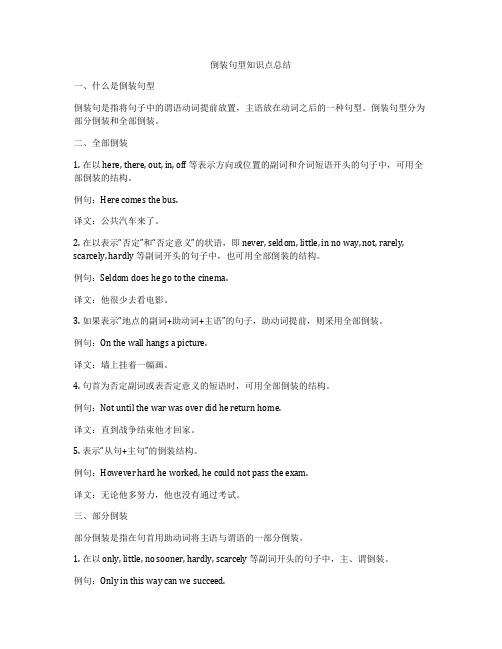
倒装句型知识点总结一、什么是倒装句型倒装句是指将句子中的谓语动词提前放置,主语放在动词之后的一种句型。
倒装句型分为部分倒装和全部倒装。
二、全部倒装1. 在以 here, there, out, in, off 等表示方向或位置的副词和介词短语开头的句子中,可用全部倒装的结构。
例句:Here comes the bus.译文:公共汽车来了。
2. 在以表示“否定”和“否定意义”的状语,即 never, seldom, little, in no way, not, rarely, scarcely, hardly 等副词开头的句子中,也可用全部倒装的结构。
例句:Seldom does he go to the cinema.译文:他很少去看电影。
3. 如果表示“地点的副词+助动词+主语”的句子,助动词提前,则采用全部倒装。
例句:On the wall hangs a picture.译文:墙上挂着一幅画。
4. 句首为否定副词或表否定意义的短语时,可用全部倒装的结构。
例句:Not until the war was over did he return home.译文:直到战争结束他才回家。
5. 表示“从句+主句”的倒装结构。
例句:However hard he worked, he could not pass the exam.译文:无论他多努力,他也没有通过考试。
三、部分倒装部分倒装是指在句首用助动词将主语与谓语的一部分倒装。
1. 在以 only, little, no sooner, hardly, scarcely 等副词开头的句子中,主、谓倒装。
例句:Only in this way can we succeed.译文:只有这样,我们才能成功。
2. 在以表示“基本上否定意义的频度词、程度副词或时间状语”如 seldom, never, not, hardly, nowhere, little, no more, at no time, by no means, in no way, in no circumstances, on no occasion, in no sense, under no conditions, under no circumstances, barely, seldom, little, rarely 等开头的句子中,主、谓倒装。
倒装句的用法 归纳型的

倒装句的用法归纳型的1、倒装句的定义倒装句是一种将句子中的某些成分(如主语、谓语、宾语、状语等)的位置进行颠倒的句式,以达到强调、平衡句子结构或满足特定表达需要的目的。
11 完全倒装完全倒装是指将整个谓语动词置于主语之前。
111 表示地点、方位的副词或介词短语位于句首时,句子采用完全倒装。
例如:“Here comes the bus” (公共汽车来了。
)“In front of the house stands a tall tree” (房子前面有一棵大树。
)112 表示时间的副词位于句首时,句子采用完全倒装。
如:“Now comes your turn” (现在轮到你了。
)12 部分倒装部分倒装是指将助动词、情态动词或系动词置于主语之前。
121 否定副词或短语位于句首时,句子采用部分倒装。
常见的否定词有:never, seldom, hardly, little, not until 等。
例如:“Never have I seen such a beautiful place” (我从未见过如此美丽的地方。
)“Not until he came back di d I know the truth” (直到他回来我才知道真相。
)122 “so +助动词/情态动词/系动词+主语”表示前面所说的情况也适用于另一人或物。
如:“He likes music So do I” (他喜欢音乐,我也喜欢。
)123 “neither/nor +助动词/情态动词/系动词+主语”表示前面的否定情况也适用于另一人或物。
例如:“I don't like coffee Neither/Nor does she” (我不喜欢咖啡,她也不喜欢。
)124 only 位于句首修饰状语时,句子采用部分倒装。
例如:“Only in this way can you learn English well” (只有通过这种方式你才能学好英语。
倒装句用法归纳

倒装句用法归纳一、完全倒装1.在There be 句型中2.用于“ here (there, now, then)+不及物动词+主语” 的句型中,或以 up, down, out, in, away, off, ahead 等副词开头的句子里,以表示强调。
⑴ Here are some flowers for you.⑵ Then began our new lesson.⑶ Out rushed the boy.⑷ Ahead sat an old man.3.当句首状语为表示地点的介词词组时。
⑴ South of the city lies a big zoo.⑵ From the valley came a frightening sound.⑶ This is our building, on top of which is flying a red flag.4.表语置于句首时,倒装结构为“表语+ 连系动词 + 主语”.⑴ Present at the meeting were Professor White, Professor Smith andmany other guests.⑵ Happy is he who has a sound mind in a sound body.⑶ Gone are the days when they could do what they liked to the Chinesepeople.⑷ Among the goods are Christmas trees, flowers, candles and toys.5.带有直接引语的句子位于引语后面或中间时,通常需全部倒装。
但如果引述动词的主语是代词,或者引述部分后面还有间接宾语,一般不倒装。
⑴ “ I agree with you.” said his parents.⑵ “ Would you like a cup of tea?” he asked politely.⑶“ Our family are going on a trip,” Meimei told me, “ and weare going by bike.”6.用于 so, nor, neither 开头的句子,表示前句所说的内容也适合于另外的人/物。
全部倒装句的用法归纳
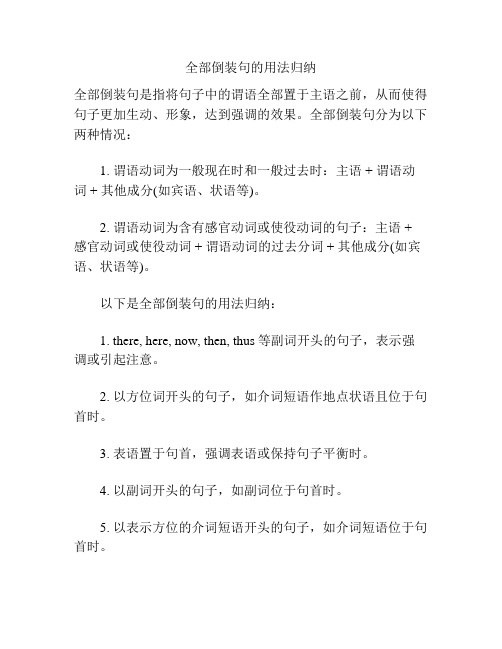
全部倒装句的用法归纳
全部倒装句是指将句子中的谓语全部置于主语之前,从而使得句子更加生动、形象,达到强调的效果。
全部倒装句分为以下两种情况:
1. 谓语动词为一般现在时和一般过去时:主语 + 谓语动词 + 其他成分(如宾语、状语等)。
2. 谓语动词为含有感官动词或使役动词的句子:主语 + 感官动词或使役动词 + 谓语动词的过去分词 + 其他成分(如宾语、状语等)。
以下是全部倒装句的用法归纳:
1. there, here, now, then, thus等副词开头的句子,表示强调或引起注意。
2. 以方位词开头的句子,如介词短语作地点状语且位于句首时。
3. 表语置于句首,强调表语或保持句子平衡时。
4. 以副词开头的句子,如副词位于句首时。
5. 以表示方位的介词短语开头的句子,如介词短语位于句首时。
6. 以某些从句开头的句子,如从属连词位于句首时。
7. 以引导词it开头的句子,如it位于句首时。
8. 以时间、地点、条件等状语从句开头的句子,如从属连词位于句首时。
9. 以表示让步的从句开头的句子,如从属连词位于句首时。
10. 以某些动名词开头的句子,如动名词位于句首时。
11. 以某些形容词或过去分词开头的句子,如形容词或过
去分词位于句首时。
12. 以某些并列连词开头的句子,如并列连词位于句首时。
13. 以某些表示强调的词语开头的句子,如词语位于句首时。
最新英语倒装句用法经典总结
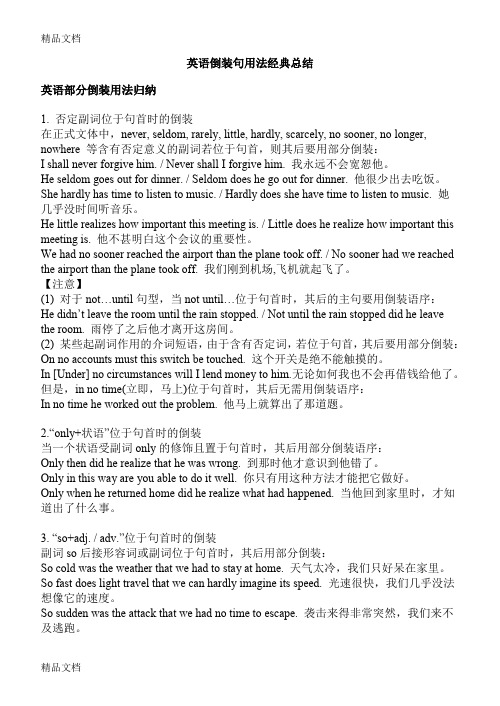
英语倒装句用法经典总结英语部分倒装用法归纳1. 否定副词位于句首时的倒装在正式文体中,never, seldom, rarely, little, hardly, scarcely, no sooner, no longer, nowhere 等含有否定意义的副词若位于句首,则其后要用部分倒装:I shall never forgive him. / Never shall I forgive him. 我永远不会宽恕他。
He seldom goes out for dinner. / Seldom does he go out for dinner. 他很少出去吃饭。
She hardly has time to listen to music. / Hardly does she have time to listen to music. 她几乎没时间听音乐。
He little realizes how important this meeting is. / Little does he realize how important this meeting is. 他不甚明白这个会议的重要性。
We had no sooner reached the airport than the plane took off. / No sooner had we reached the airport than the plane took off. 我们刚到机场,飞机就起飞了。
【注意】(1) 对于not…until句型,当not until…位于句首时,其后的主句要用倒装语序:He didn’t leave the room until the rain stopped. / Not un til the rain stopped did he leave the room. 雨停了之后他才离开这房间。
英语倒装句的四种基本句型例句

英语倒装句的四种基本句型例句嗨,小伙伴们!今天咱们来好好唠唠英语倒装句的四种基本句型,这可真是英语学习里超有趣的一部分呢。
就像一场奇妙的语言魔术,让句子变得超级有特色。
**一、完全倒装(Full Inversion)**完全倒装就是把整个谓语动词都放到主语之前啦。
这就好比是把一场演出的主角(主语)和配角(谓语)的出场顺序完全颠倒了一下,给人一种很新奇的感觉。
例句1:There goes the bell.(铃响了。
)你看,正常的语序应该是The bell goes there. 但是这样一倒装,就有一种突然性,就像你正等着什么事情发生,然后“铃就响了”,这种表达更加生动。
我还记得我刚学这个的时候,我同学问我:“为啥要这么说呀?直接说The bell goes there不就得了?”我就跟他说:“哎呀,这就像你去看魔术表演,魔术师要是按平常的方式出牌,那还有啥惊喜呢?这种倒装句就像魔术里的大变活人,突然把主语和谓语的位置变了,让句子变得超酷。
”例句2:Here comes the bus.(公共汽车来了。
)想象一下,你在车站等车等得心急火燎的,然后你大喊一声“Here comes the bus”,是不是感觉比“The bus comes here”更带感呢?这时候句子就像是一个充满活力的小助手,快速地把重要的信息“bus来了”传达给你。
例句3:Away flew the birds.(鸟儿飞走了。
)这个句子要是正常说就是The birds flew away. 可一旦倒装,就像是我们在描述一个很突然的画面,鸟儿“嗖”的一下就飞走了,那种动态感更强了。
我跟我的英语老师讨论这个句子的时候,老师说:“你看,这种倒装就像是给句子加了个加速器,让动作更迅速地呈现在读者或者听者的脑海里。
”我当时就觉得,哇塞,真的是这样呢!**二、部分倒装(Partial Inversion)**部分倒装呢,就是只把助动词、情态动词或者be动词放到主语前面,主要动词还在主语后面呢。
- 1、下载文档前请自行甄别文档内容的完整性,平台不提供额外的编辑、内容补充、找答案等附加服务。
- 2、"仅部分预览"的文档,不可在线预览部分如存在完整性等问题,可反馈申请退款(可完整预览的文档不适用该条件!)。
- 3、如文档侵犯您的权益,请联系客服反馈,我们会尽快为您处理(人工客服工作时间:9:00-18:30)。
倒装句用法总结专题英语最基本的语序是主语在前,谓语动词在后。
但有时由于句子结构的需要或表示强调,就要采用倒装形式。
倒装分为全部倒装和部分倒装,将谓语动词完全移到主语之前称为完全倒装,只将助动词或情态到主语之前称为部分倒装一、完全倒装(主谓倒装)是指把谓语全部提到主语的前面。
例:In a lecture hall of a university in England sits a professor.1.以here, there,now, then引导的句子,要完全倒装。
这种句子中的谓语动词通常是不及物动词。
如:Here comes the train! / There goes the bell!注意:若代词作主语,只把该副词提前主谓语序不变。
Here he comes . / Here it is .2句首以out , in , up ,away , down 等副词开头,句子要完全倒装。
(注意,这时句子的主语也必须是名词。
如果是人称代词,也不能使用倒装结构。
)如:Up went the rocket. /Up it went.3. 介词短语作状语在句首,句子要完全倒装。
注意,这时句子的谓语动词通常是不及物动词。
如:In the front of the lecture hall sat the speaker.4.表语置于句首,且主语较长或结构较复杂的句子要用全部倒装。
如:Gone are the days when we ha nothing to eat.5.so/ neither/ nor 表前面所说的情况也适合于后者,其倒装结构为“so/ neither/ nor+助动词/系动词/情态动词”,这里的主语同前一个句子的主语指的不是同一人或物。
如:She has finished her homework, so has her brother.She hasn’t gone there, neither/ nor has he.二、部分倒装(助动词倒装)是指把谓语的一部分(助动词)提到主语的前面。
例:Never in my life have I seen such a thing.1.用于疑问句中。
如:How did you do that? Did you see the film yesterday?2. if 从句中如有were ( had , should ) , if 省去后,要部分倒装,把were,had,should提到主语前面。
如:If you had come yesterday, you would have seen him.---Had you come yesterday, you would have seen him.3.as 引导的让步状语从句,要部分倒装(表语、状语倒装)。
有以下几种形式:1)副词置于句首。
如:Much as I like it (=Although I like it very much), I will not buy it.2)动词置于句首。
如:Wait as you may (= Although you may wait), he will not see you.3)形容词或名词置于句首。
如:Proud as the nobles are (=Although the nobles are proud), they are afraid to see me.Child as he is (=Although he is a child), he can tell right from wrong.注意:如果名词前有形容词修饰时,as引导的倒装句中要保留不定冠词。
如:A bad-tempered man as he is (=Although he is a bad-tempered man), he loves me deeply.4.句首为否定词或否定意义的词语时,句子要部分倒装。
( not , not only , never , little , seldom , not until, hardly ( scarcely ) , no sooner, not once, at no time,... ) Little do we know about him.No sooner had he closed his eyes than he fell asleep.Seldom does he come back on Sundays.Not until he came back did I know about it.5.only 在句首引导状语,或not until 引导的状语在句首,主句要部分倒装。
如:Only then did I realize the important of English. / Only when a child grows up does he understand his parents’ intentions.但若only修饰的是句子的其它成分,则无需倒装。
如:Only socialism can save China. (only修饰句子的主语,仍用正常语序)6.not only ... but also ... 引导两个并列句,前倒后不倒。
如:Not only does he do well in his lessons, but also he often helps others with their lessons.7.在以often, well, many a time, now and again等方式或频度副词(短语)开头的句子中,要用部分倒装结构。
如:Many a time has John given me good advice. / Often have we made that test.8. 用于某些表示祝愿的句子里。
May you succeed!9. so或so引导的短语放在句首,要部分倒装。
So loudly did he speak that even people in the next room could hear him.so…that结构中的倒装。
有时要强调so 所修饰的形容词或副词,常将so连同它所修饰的形容词或副词一起提到句首。
这时,主句要用倒装结构。
如:He runs so fast that he is far ahead of others.---So fast does he run that he is far ahead of others.He is so clever that he can work out all the difficult problems in the book.--So clever is he that he can work out all the difficult problems in the book.(全部倒装)10.状语位于句首表示强调或使句子平衡,或使上下文紧密衔接,句子要部分倒装。
倒装句的用法具体小结(下面的小结与以上的大总结可能有些重复,可是下面都是一些做题常用知识点,希望大家能理解地记忆好,这样的话,对于大家以后解倒装句的题就能很容易。
)1 . 在以here , there , in , out , up , down , away , back , now , then 等副词开头的句子里,如果主语是名词,常用全部倒装。
Out rushed the boys . /Then followed three days of heavy rain .若代词作主语,只把该副词提前主谓语序不变。
Here he comes . / Here it is .2 . 当句首状语是表示地点的介词词组时,也常常引起全部倒装。
South of the city lies a big steel factory .3 . 以带有否定意义而且修饰全句的词开头的句子,要用“部分倒装”语序( 倒装的方法跟变一般疑问句的方法相似) 。
这类常见词有never , hardly , seldom , not , not only , not until ( 引导从句时,主句“部分倒装”) ,little , rarely , no sooner . . . than , hardly . . . when , scarcely . . . when。
例:Never shall I do this again .其中no sooner . . . than , hardly . . . when , scarcely . . . when 表示“一……就……”的意思。
no sooner , hardly , scarcely 引出的主句要用“部分倒装”形式的过去完成时,than , when 引出的从句用过去时。
No sooner had I got home than it began to rain .如果带有否定意义的词不是修饰全句,只是修饰主语,那么句子的主谓不必倒装。
Scarcely a sound came from among the crowd .4 . so 修饰形容词或副词,only 修饰副词或状语放在句首时“部分倒装”。
So badly was he injured in the accident that he was sent to the hospital for treatment . /Only in this way can you master English .如果only 修饰主语,句子则不倒装。
例如:Only Wang Lin knows this .5. neither , nor 或no more 放在句首,作“也不”讲时,所引导的句子部分倒装。
He can’ t answer the question . Neither can I .6.为了保持句子平衡或为了强调表语或状语,或使上下文紧密衔接时,需倒装。
Gone are the days when we used foreign oil .7.由as , though ( although ) 引导的表示“虽然”,“尽管”的让步状语从句,用倒装语序,即把从句中的表语或状语等放在as 的前面。
1.______can you expect to get a pay rise.(2001北京春季卷)A. With hard work B.Although work hard C.Only with hard work D.Now that he works hard2.I failed in the final examination last term and only then the importance of studies.(2004重庆卷)A. I realizedB. I had realizedC. had I realizedD. did I realize3.----I would never come to this restaurant again. The food is terrible. ----______. (2004全国卷)A. Nor am IB. Neither would IC. same with meD. So do I4. ____snacks and drinks, but they also brought cards for entertainment when they had a picnic in the forest.(2004上海卷)A. Not only they broughtB. Not only did they bringC. Not only brought theyD. Not only they did bring5____about wild plants that they decided to make a trip to Madagascar for further research.(2005江苏卷)A. So curious the couple wasB. So curious were the coupleC. How curious the couple wereD. The couple was such curious6. —David has made great progress recently. —_____,and _____. (2005上海卷)A. So he has; so you haveB. So he has; so have youC. So has he; so have youD. So has he; so you have7.Maybe you have been to many countries, but nowhere else ____such a beautiful palace.(2004年辽宁卷)A.can you find B.you could find C.you can find D.could you find8.______, Carolina couldn't get the door open. (05广东卷)A. Try as she mightB. As she might tryC. She might as tryD. Might she as try9.Never before _______ in greater need of modern public transport than it is today. (2005上海卷)A. has this city beenB. this city has beenC. was this cityD. this city was10._____, he talks a lot about his favorite singers after class. (05重庆卷)A. A quiet student as he may beB. Quiet student as he may beC. Be a quiet student as he mayD. Quiet as he may be a student11.In the dark forests ________, some large enough to hold several English towns.(2005辽宁卷)A.stand many lakes B.lie many lakes C.many lakes lie D.many lakes stand(key: CDBBB BAAAB B)详细的答案讲解1.only所修饰的状语(副词、介词短语或状语从句)位于句首时,谓语动词要部分倒装。
